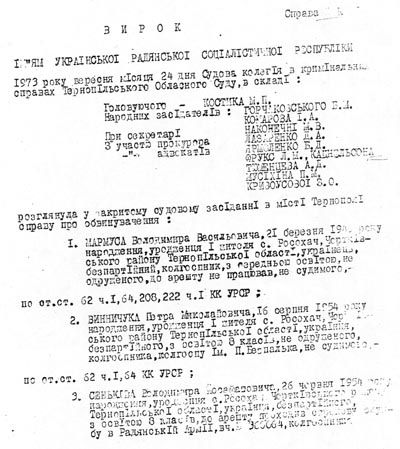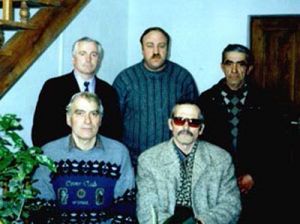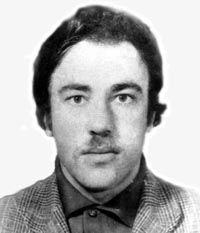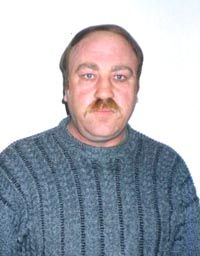SENKIV, VOLODYMYR YOSAFATOVYCH (b. June 24, 1954, in the village of Rosokhach, Chortkiv district, Ternopil region)
Member of a nationalist and patriotic underground organization.
From a nationally conscious peasant family that had aided UPA underground fighters. The second of five children. He completed 8th grade at Rosokhach school in 1968, then studied to become a driver at a rural vocational school in the village of Tovste, Zalishchyky district. He enjoyed reading historical literature, was interested in the UPA's struggle for independence, and listened to foreign radio broadcasts. He was struck by the barbaric acts of destroying memorial crosses and the grave of the Sich Riflemen in his village, as well as the destruction of the church. After the arrests of Ukrainian intellectuals in 1972, in conversations with V. MARMUS, the idea emerged to create an underground patriotic youth organization to continue the struggle for independence. V. MARMUS drafted the text of an oath of allegiance to Ukraine and persuaded P. VITIV to join, while Senkiv recruited his former classmate, P. VYNNYCHUK.
On November 5, 1972, in a forest clearing where UPA partisans had previously camped, in a solemn ceremony—with candles, kneeling before a cross and an icon of the Mother of God—the young men took their oath. But even before that, in late October 1972, Senkiv, together with P. VITIV, damaged the monument to the “Soviet soldier-liberator” in retaliation for the destruction of the grave of the Sich Riflemen in the village, which had been erected by villagers in 1942. On November 8, together with P. VYNNYCHUK and V. MARMUS, he tore down red flags from the medical station and the bathhouse, which had been hung for the October Revolution holidays.

He served his sentence in camp VS-389/36 in the village of Kuchino, Chusovoy district, Perm region, where he communicated with S. SAPELYAK, L. LUKYANENKO, Y. SVERSTYUK, Y. PRONYUK, V. LISOVYI, O. SERHIYENKO, and others. He took an active part in producing informational materials (finely rewriting texts on thin paper) and smuggling them out, including through his father during a visit. He participated in protest actions and was placed in the punishment cell three times in two years. In the fall of 1975, he was transferred to camp VS-389/37, in the village of Polovynka, Chusovoy district, Perm region, where nearly all his co-defendants were brought.
In the summer of 1977, he arrived in exile in the village of Lvivka, Parabel district, Tomsk region. He worked as a mechanic in a tractor brigade. There was nowhere to live and nothing to live on; he lived half-starving. A month later, he was transferred to Parabel. He worked as a driver on an oil pipeline construction site, transporting workers to their jobs, then worked as a mechanic. In the last year of his exile, 1980, he married Vira Struchalina. Because his wife had an elderly mother and grandmother, he remained there to live and work, hoping to one day return to Ukraine. This came true on September 22, 1999. They moved to the city of Borshchiv with their son Oleksandr (b. 1980) and daughter Kateryna (b. 1982). In 2000, they relocated to the village of Sosulivka, Chortkiv district.

He was rehabilitated in accordance with the Law of the Ukrainian SSR of April 17, 1991, “On the Rehabilitation of Victims of Political Repressions in Ukraine.” He heads the village branch of the Republican Christian Party. His name, along with the names of all the members of the Rosokhach youth organization, was immortalized on January 26, 2012, on a memorial plaque on the building of the Chortkiv Pedagogical College, where the youths had hung a flag.
By a decree of the President on August 18, 2006, Senkiv was awarded the Order “For Courage,” First Class.
Bibliography:
“Memorandum of the Central Committee of the Communist Party of Ukraine to the Central Committee of the CPSU on the activities of nationalist groups in the Ivano-Frankivsk, Lviv, and Ternopil regions of Ukraine. September 27, 1973.” In *Natsionalni vidnosyny v Ukrayini XX st.* [National Relations in Ukraine in the 20th Century]. Kyiv: Naukova Dumka, 1994, pp. 418–420.
*Visnyk represiy v Ukrayini* [Herald of Repressions in Ukraine]. Foreign Representation of the UHG. Edited and compiled by N. Svitlychna. New York, 1980–1985. 1981: 4-50.
Kasyanov, Heorhiy. *Nezhodni: ukrayinska intelihentsiya v rusi oporu 1960-1980-kh rokiv* [The Dissenters: The Ukrainian Intelligentsia in the Resistance Movement of the 1960s–1980s]. Kyiv: Lybid, 1995, p. 142.
Marmus, Volodymyr. “Prapory nad mistom” [Flags Over the City]. *Ternystyi Shliakh* (Ternopil), 1998, no. 3 (323), January 9; Ibid. // *Molod Ukrayiny*, 1998, no. 7 (17638), January 22.
Rusnachenko, Anatoliy. *Natsionalno-vyzvolnyi rukh v Ukrayini* [The National Liberation Movement in Ukraine]. Kyiv: Olena Teliha Publishing House, 1998, p. 208.
Vatsyk, Andriy. “Tsinoyu vlasnoyi svobody” [At the Price of Their Own Freedom]. *Ternopilska Hazeta*, 1999, no. 4 (160), January 21.
Interview with V. Senkiv, April 4, 2000. https://museum.khpg.org/1121356251
*Yunaky z ohnennoyi pechi* [Youths from the Fiery Furnace]. Kharkiv Human Rights Protection Group. Compiled by V. V. Ovsienko. Kharkiv: Folio, 2003, pp. 111–116 et al.
Marmus, Volodymyr. *Dolya obrala nas: Spohady, dokumenty, statti* [Fate Chose Us: Memoirs, Documents, Articles]. Ternopil: Printerinform, 2004, 236 pp.
*International Biographical Dictionary of Dissidents in Central and Eastern Europe and the Former USSR. Vol. 1. Ukraine. Part 2.* Kharkiv: Kharkiv Human Rights Protection Group; “Prava Liudyny,” 2006, pp. 687–689. https://museum.khpg.org/1127974961
*Rukh oporu v Ukrayini: 1960 – 1990. Entsyklopedychnyi dovidnyk* [The Resistance Movement in Ukraine: 1960 – 1990. An Encyclopedic Guide]. Preface by Osyp Zinkevych and Oles Obertas. Kyiv: Smoloskyp, 2010, p. 581; 2nd ed.: 2012, pp. 661–662.
Vasyl Ovsienko, Kharkiv Human Rights Protection Group. December 12, 2002. Corrected by V. Senkiv, January 3, 2003. Last reviewed July 22, 2016.

